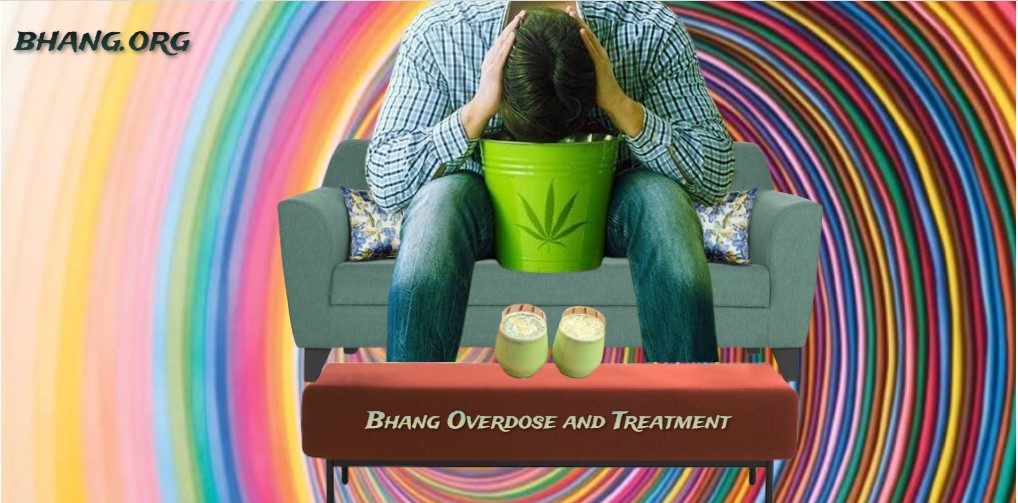What is Bhaang
Bhang, a paste crafted from the buds and leaves of the Cannabis sativa plant, is commonly incorporated into food and beverages. It is believed to offer relief from pain, muscle spasms, seizures, nausea, and vomiting. However, it also poses risks and should be avoided by certain individuals.
This edible mixture, derived from the buds, leaves, and flowers of the female cannabis plant, has been a part of Indian culinary and religious traditions for millennia. It holds significance in Hindu rituals and festivals, such as the popular spring celebration of Holi.
Furthermore, Bhang is utilized in Ayurvedic medicine, where it is touted as a remedy for various ailments, including nausea, vomiting, and physical discomfort.
The Benefits of Bhang:
- Stress Relief: Bhang is renowned for its ability to induce relaxation and reduce stress. Its cannabinoids interact with the endocannabinoid system, aiding in mood regulation and anxiety reduction.
- Pain Management: Many users find bhang effective in alleviating chronic pain. CBD, a key compound in hemp, possesses anti-inflammatory properties that contribute to pain relief.
- Sleep Support: Bhang is considered a natural aid for sleep-related issues. Its calming effects can enhance sleep quality for some individuals.
- Anti-Nausea Properties: Bhang has a long history of use in alleviating nausea and vomiting, particularly beneficial for those undergoing medical treatments.
Understanding Potential Side Effects:
While bhang offers various benefits, it’s important to be mindful of potential side effects, especially for newcomers:
- Dry mouth: also known as “cottonmouth,” is a prevalent side effect that can be alleviated by maintaining proper hydration.
- Dizziness: Some individuals may experience mild dizziness, especially with high doses. Starting with a small dose and gradually increasing can help mitigate this effect.
- Interaction with Medications: Consult a healthcare professional before incorporating bhang into your regimen, as it may interact with certain medications.
- Psychological Effects: High doses of bhang can lead to temporary alterations in perception. It’s crucial to practice responsible consumption and understand our individual tolerance levels.
Bhaang Overdose Symptoms & Signs
While uncommon, marijuana overdose remains a possibility in certain situations. Such an overdose can affect mental state, heart function, and result in pale skin. Signs of consuming too much weed could include:
Severe anxiety or panic attacks.
- Psychotic episodes, characterized by detachment from reality, paranoia, hallucinations, delusions, or loss of identity.
- Impaired judgment, perception, and coordination, increasing the risk of accidents or fatality.
- Accelerated heart rate, chest discomfort, or cardiac events.
- Uncontrollable tremors or seizures.
- Pallor.
- Unresponsiveness.
- Sudden elevation in blood pressure accompanied by headaches.
For severe symptoms, seek medical assistance immediately—call 911 or proceed to the nearest emergency room—to ensure proper monitoring and management of potential complications and adverse reactions. The noticeable effects of smoked marijuana typically persist for 1 to 3 hours, while those from marijuana-infused edibles or beverages may endure for several hours.
What to Do if You Have A Marijuana Overdose?
If you suspect a marijuana overdose, it’s crucial to seek prompt medical attention. Take the following steps:
- Call 911 immediately.
- In the event of an overdose, transport the individual to the nearest emergency room. Never attempt to drive yourself if you are overdosing.
- If you’re overdosing and alone, reach out to someone for help.
- Remain with the individual who is experiencing an overdose to observe their condition for any signs of deterioration.
- If the individual stops breathing, administer CPR immediately if you are trained to do so.
- In the emergency room, medical professionals may administer sedatives, provide respiratory support, conduct a chest X-ray, administer IV fluids, and prescribe medications to alleviate symptoms.
How many hours does bhang last?
Bhang, derived from the leaves of the Cannabis plant, mirrors the effects of marijuana, encompassing intoxication, euphoria, drowsiness, short-term memory loss, and impaired focus. It can also induce an altered perception of time, hallucinations, delusions, and difficulty with cognitive tasks. Expect increased appetite and potential anxiety, along with a slight rise in heart rate, making it advisable for individuals with heart conditions to avoid. Pregnant women are also advised against consuming bhang due to potential risks to the baby.
These effects stem from THC, the primary compound in cannabis. When ingested, THC takes longer to manifest its effects compared to smoking, typically requiring 30 to 90 minutes. Its peak effects occur 2-3 hours post-ingestion, lasting 4 to 12 hours depending on the dosage consumed.
Prevention of Bhaang Overdose
Recognizing the potential for marijuana to cause overdose is essential for preventing such incidents. To avoid marijuana overdose, consider the following measures:
- Abstain from abusing marijuana.
- Reduce marijuana consumption.
- Be mindful of the hazardous interactions between marijuana and alcohol, and avoid combining them.
- Acknowledge the decrease in tolerance after abstaining from marijuana for a period.
- Stay hydrated.
- Be cautious of any additional substances present in marijuana.
- Understand underlying health conditions that may worsen with marijuana use.
- Modify social circles and environments to minimize or eliminate exposure to marijuana.
- Seek professional assistance for marijuana addiction.
Additionally, it’s crucial to avoid situations involving marijuana that can be life-threatening, such as driving under the influence. According to AAA, cannabis-related fatalities rose from 8% in 2013 to 17% in 2014. There are various risks associated with marijuana use, ranging from minor to severe, but treatment options are available at any stage of marijuana use.
Types of Treatment for Marijuana Addiction
While marijuana overdose symptoms are typically mild, traditional drug treatment options can aid in recovery from the residual effects. Here are some treatment types:
- Inpatient Treatment: Involves round-the-clock medical care and therapy for individuals dealing with drug abuse, addiction, or overdose. Patients reside onsite for 30 to 90 days before transitioning to a lower level of care.
- Outpatient Therapy: Requires a commitment of 1 to 2 hours per day, 1 to 2 days per week. This less structured therapy is suitable for individuals managing work and family commitments while undergoing treatment. Some may opt for outpatient therapy following higher levels of care.
- Partial Hospitalization: Takes place in a hospital setting but allows patients to return home at night. Similar to inpatient treatment but lacks 24-hour support. Patients typically attend sessions 4 to 5 days a week for 6 to 8 hours each day.
- Intensive Outpatient Therapy (IOP): Typically consists of 3-hour sessions at least 3 days a week and is more rigorous than regular outpatient therapy. Despite the intensive schedule, it accommodates work and family responsibilities and offers significant support.
Therapy Types for Marijuana Addiction
- Holistic Therapy: Focuses on treating the individual as a whole, addressing physical, emotional, and spiritual aspects to achieve optimal health and wellness. This approach promotes a healthier lifestyle and mental well-being alongside addressing marijuana addiction.
- Cognitive Behavioral Therapy (CBT): Equips individuals with skills to identify and replace faulty thoughts and patterns that contribute to drug use with healthier alternatives.
Conclusion:
While bhang and marijuana offer potential benefits, they also carry risks, including the possibility of overdose. It’s essential to be aware of these risks and take precautions to prevent adverse reactions. Seeking professional help is crucial for individuals struggling with marijuana addiction, as various treatment options are available to support recovery at any stage of use.
FAQs About Bhang and Marijuana Overdose:
What are the potential side effects of consuming bhang?
Side effects may include dry mouth, dizziness, and psychological effects like altered perception.
What should I do if I suspect a marijuana overdose?
Obtain urgent medical assistance by dialing 911 or visiting the nearest emergency room.
How long does it take for the effects of bhang to manifest?
Effects typically appear within 30 to 90 minutes of ingestion and can last for 4 to 12 hours.
How can I prevent a marijuana overdose?
Strategies include reducing marijuana consumption, staying hydrated, and being mindful of interactions with other substances.
What types of treatment are available for marijuana addiction?
Treatment options include inpatient treatment, outpatient therapy, partial hospitalization, intensive outpatient therapy, holistic therapy, and cognitive behavioral therapy (CBT).





Leave a Reply